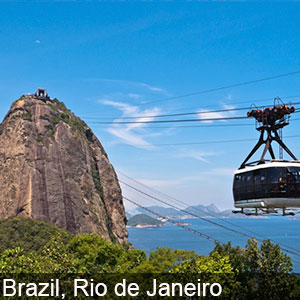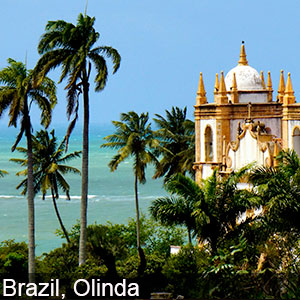
Brazil Jewish Heritage Tour
Overview / Highlights
6 NIGHTS / 7 DAYSBrazil is the largest country in South America, commanding four fifths of the continent, larger than continental USA, with a population of approximately 208 million people. It’s a true “melting pot” with people of all colors and multi ethnic backgrounds. Brazil’s religion was formed by the confluence of the Catholic Church, atavistic traditions of enslaved Africans, and the advent of the Portuguese colonization of Brazil in the 1500s. Brazil is home to a variety of religious with Roman Catholicism being the predominant faith, boasting the world's largest Catholic population. Adding to the mix, is a small component of approximately 100,000 to 120,000 Jews, most of whom identify themselves as secular and Zionist. One of the best kept secrets about Brazil’s Jews is that they were the early settlers, having arrived over 500 years ago. The famous explorer Gaspar da Gama, a Converso, accompanied by Portuguese admiral Pedro Alvares Cabral, was the first European to step foot in Brazil.
CountriesBrazil | CitiesSao Paulo, Rio de Janeiro, Recife |
Tour Program Summery Outline
| Click |
Features
|
|
Interest
Adventure / Beaches / Cruises / Cultural / Eco Tours / FAMILY ADVENTURES / Flora / Luxury



Day 1: Arrive Sao Paulo (City Tour)
Welcome to Sao Paulo, Brazil’s vibrant financial center, among the world's most populous cities, with numerous cultural institutions and a rich architectural tradition. Its iconic buildings range from its neo-Gothic cathedral and the 1929 Martinelli skyscraper to modernist architect Oscar Niemeyer’s curvy Edifício Copan. The colonial-style Pátio do Colégio church marks where Jesuit priests founded the city in 1554.São Paulo is a city of superlatives. It’s the largest city boating the largest economy by GDP in Latin America. Considered a cosmopolitan city and a melting pot, among its 11-million population you will find the largest Japanese colony outside Japan, more than 2.5 million Italian decedents, Portuguese, Spaniards, Arabs, Brazilians from different areas, and the largest Jewish community in Brazil.
This afternoon an introductory panoramic tour of Sao Paulo. Get to know the history of this fascinating city and see the highlights of the largest metropolis in South America. We begin with Ibirapuera Park, where you will see the State Congress and the Obelisk, the tallest monument of Sao Paulo. We continue through the chic streets of Jardins area, reaching the famous Avenida Paulista, the most important street in town. Here we view some of the symbolic and significant edifices in the city such as the Copan and Italia buildings, the Municipal Theater, the City Hall; the Pátio do Colégio (where the city was founded), the Saint Benedict Monastery and the gorgeous Sé Cathedral. Next stop is at Sao Paulo's highest viewing spot, located at the top of the Altino Arantes Building, also known as the Banespa's Tower. We continue to the Liberdade neighborhood (the Asian quarter). Sao Paulo is home to the largest concentration of Japanese outside of Japan. Nowhere is that more evident than in the central neighborhood of Liberdade, Sao Paulo’s very own Japantown. With its roads lined with oriental suzuran-to streetlights, the neighborhood has a distinctly East Asian feel year-round. We conclude our visit at the Luz Railroad Station, where the Pinacoteca Museum, the Holly Art Museum and the amazing Municipal Market are located.
Overnight at selected hotel in Sao Paulo.
Day 2: Sao Paulo (Jewish Interest Tour)
We begin our full day Jewish heritage tour at the Jewish Center, an organization that promotes ties between the Jewish community Brazilian societies; Higienopolis, a neighborhood with a strong Jewish presence; and the Kehilat Israel synagogue, the oldest in Sao Paulo. Kehilat Israel is located in the historic Jewish quarter of Bom Retiro where you can find some traditional kosher stores and restaurants. You will also visit Hebraica, one of the largest and most complete country clubs in South America, with more than 22 thousand members; the Shalom Community, a traditional synagogue and center (Masorti movement) maintained by Jews who came from America, that runs a day care center for handicapped adults; and the Congregacão Israelita Paulista (CIP). Founded by German Jews, the CIP holds Conservative and Reform services, being the largest synagogue in Latin America. The tour finishes at the Lasar Segall Museum, a Museum dedicated to the famous painter, engraver and sculptor born in Lithuania who lived in São Paulo for many years.Overnight at the selected Sao Paulo hotel. (B)
Day 3: São Paulo / Rio de Janeiro (Sugarloaf Mountain)
Welcome to Rio de Janeiro. Rio … the very sound of it evokes images of sun, fun and rhythm of the sensuous samba. Blessed with a wonderful natural setting, nestled among towering hills and the sea, watched from above by Christ the Redeemer atop Corcovado Mountain, and surrounded by tropical forests and lagoons, Rio de Janeiro has transformed into one of the world’s most beautiful cities. Meeting services upon arrival and transfer to the hotel.This afternoon we drive along Copacabana and Ipanema, two of the world's most famous beaches continuing to Flamengo Park en route to Rio's Urca neighborhood. From here we ascend aboard glass cable cars to the top of Sugar Loaf Mountain - 1,200 feet of sheer rock overlooking Guanabara Bay and its islands for a breathtaking view of the surrounding areas, including the Rio-Niteroi Bridge and Corcovado Mountain crowned by the famous Art Deco statue of Christ the Redeemer.
Overnight at the selected hotel. (B)
Day 4: Rio de Janeiro (Corcovado Mountain & Jewish Interests)
This morning we drive through the fashionable Lagoa District to the base of Corcovado Mountain for a short train ride to the summit. Here, at 2,400 feet above the city stands one of South America's most famous landmarks, the 125-foot statue of "Christ the Redeemer", one of the new Seven Wonders of the World. The panorama of the city below is testament to why most visitors consider Rio to be one of the most spectacular and beautiful cities in the world. On a clear day a 360 degree panorama view covering the entire city, the beaches, the forest, mountains, Maracana (soccer) Stadium, Rio Niteroi Bridge, Botanic Garden and more.This afternoon we explore Jewish life in Rio de Janeiro. New Christians from Portugal immigrated to Rio de Janeiro from the 16th to the 18th centuries, and they played a significant role in the city's social and economic life. The Inquisition accused and prosecuted more than 300 New Christians in the city's region for practicing Judaism. With the proclamation of the independent Brazilian empire (1822) and the promulgation of the Constitution (1824), which espoused some level of religious tolerance, some individual European Jewish dealers and immigrants began to appear in Rio de Janeiro, which was the capital and one of the most important harbors of the country. One of the prominent individuals among these first newcomers was Denis de Samuel (1782–1860), a young immigrant from England who gained great success and influence and earned the title of baron from the king of Portugal. Another prominent dealer who had business in Rio de Janeiro was Bernard Wallerstein.
Rio de Janeiro is home to close to 40 thousand Jews. Your day will be dedicated to seeing the most important landmarks and interacting with some members of the community. Start at Associacão Religiosa Israelita (ARI) Synagogue, a reformist synagogue located in the Botafogo area. Stop at Yitzhak Rabin Park, a small belvedere that holds a monument in honor of the former Israeli Prime Minister. Take pictures at Chaim Weitzmam Square, across the street from Anne Frank public school. Then visit the Paço Imperial Museum followed by the Great Temple: the first synagogue in Rio. Nowadays the temple is considered a landmark of Rio de Janeiro and is used mainly for special events and parties. Your next stop is at the Jewish Museum, which houses permanent exhibitions about the history of the Jewry of Rio de Janeiro as well as different aspects of Jewish traditions. You have time for lunch (not included) at the kosher restaurant located inside CIB (Club Israelita Brasileiro). Time permitting; we will stop for a visit to the Bar Ilan School, an orthodox school, and its synagogue. From there we go to the Beit Lubavitch Synagogue, which is also a center for Jewish Studies. Our tour concludes at the headquarters of H. Stern for an informative visual explanation of how gemstones are discovered, mined and made into beautiful jewelry.
Overnight at the selected hotel. (B,L)
Day 5: Rio de Janeiro / Recife
Today we transfer to the airport in Rio de Janeiro for the flight to Recife, the capital of Brazil’s northeastern state of Pernambuco. Recife Antigo, on its own island by the harbor, is the historic old town center dating to the 16th century. Its sister city is Olinda, a charming colonial town on Brazil’s northeast coast. Founded in 1535 by the Portuguese, it’s built on steep hillsides and distinguished by its 18th-century architecture, baroque churches, convents, monasteries and brightly painted houses. Originally a center for the sugarcane industry, it’s now known as an artists’ colony, with many galleries, workshops and museums.Recife and Olinda stand within sight of each other on Brazil's Northeast coast—one city on a hilltop, the other at the mouth of a river—and are less than 15 minutes apart. The first settlements in the region of Recife date back to 1534, when The Captaincy of Pernambuco was assigned to Duarte Coelho Pereira who founded the villages of Igaraçu and Olinda. The captaincy prospered, exporting first pau-brazil (Brazil-wood) then sugarcane. Olinda was the capital and Recife was just a small village with a port from which commodities were exported. Nowadays Recife and Olinda are considered two jewels of Brazil. Walking through the hills of Olinda and the valley of Recife, one is amazed by the contrasts between the two cities; modern streets and baroque churches, urban beaches and colonial buildings, cosmopolitan attractions and craft markets. Recife and Olinda forge an alliance between past and present—one a modern multicultural city, the other a city seeped in history—both rich in their intertwined cultures and combined histories.
The afternoon is at leisure to relax on the beach or explore Recife on your own. Depart in the early evening for a leisurely catamaran ride along the Capiberibe River. See the historic areas of Recife and the bridges built during the Dutch occupation, which have granted Recife the nickname “Venice of Brazil”.
Overnight at the hotel of your choice. (B)
